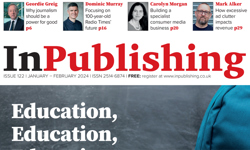"Recession proof" is a phrase everyone would like to be able to apply to their industry. One that can is the pet industry. The economy goes belly up; you might lose your job, but you will still feed your dog (probably on the same premium brand you did before), you still de-louse him, take him to the vet, insure him and coddle him. This does not mean that every pet business is bound to succeed but it does mean that if you hit on the right business model then you have a long and rosy future. One such company is K9 Media.
K9 Media is a Mansfield based publisher of more than 30 online and print products for dog enthusiasts, set up in 1999 by the then 23 year old Ryan O’Meara. Ryan had a passion for dogs and a strong entrepreneurial streak. He left school at 16 and got a job as a dog trainer. He spent five years perfecting his craft but earning no money. What he wanted to do was set up a business that combined dogs with commercial opportunity. All he needed was an idea, a spark – a "eureka" moment.
That moment arrived with the realisation that there was, in Ryan’s opinion, a shortage of information for dog owners. Ryan was into football and regularly bought footie mags; he was also into dogs but had NEVER bought a dog magazine. Why? At the time of the launch of K9 Media there were five magazines, with a combined circulation of approx 100,000, servicing 6.9m dog-owning UK households. A combination of the size of the market and the fact that the current publications were barely scratching the service lead to the setting up of K9 Media. As Ryan points out, "more people have dogs than watch football, but this was not represented on the newsstand."
Web first, print second
With no print publishing experience but a self-taught appreciation of the burgeoning internet, K9 Media was first and foremost a web publisher. Ryan decided that they needed to create a portfolio of brands servicing the dog owning community. The initial thinking was to segment the market and create a web site for each stage of the pet ownership cycle. Thus, the first tranche of web sites included: www.breedersdirectory.co.uk, www.dogservices.co.uk and www.dog-groomers.co.uk. Ryan raised enough finance to employ sales staff and a web designer and there followed a frenetic period of web building and sales activity. They kept the entry level low for advertisers (although it doubled at renewal stage) and worked hard to optimise traffic to the sites. Ryan’s own role was thinking up ideas and playing the search engine optimisation game. In 2001, a total of 1.3m unique users visited their sites – a figure achieved almost entirely by intelligent use of search engines.
The launch of a print magazine was not high on their list of priorities. This all changed with the realisation that the main players in the pet industry – blue chip companies such as Proctor & Gamble, Mars and Colgate – did not have a web strategy. They liked what K9 Media was doing but, in those days, were not prepared to divert money away from traditional media. To get onto their schedules K9 Media had to go into print. So they did! K9 Magazine, a quarterly, was launched in 2002.
Ryan was not interested in creating a me-too title competing for a slice of the 100,000 or so existing purchasers of dog magazines. He was much more interested in finding a way of making big inroads into the wider dog owning public – people who liked dogs but who had no professional interest in them and who might not even describe dogs as their number one hobby. His idea was a glossy lifestyle magazine for dog lovers – a magazine that talked about dogs but with the style, format and production values of the mainstream glossies. To give you some idea of the angle they took, three of the cover stories for issue 11 were: "Caprice on her life, career and love of dogs", "Drugs, bombs & guns – a day in the life of a police dog" and "Well groomed – expert grooming advice for you and your dog."
The circulation challenge
K9 Magazine was primarily an advertising vehicle aimed at securing a slice of the big media budgets of the blue chip suppliers, so the challenge was how to get the all important advertising from a standing start. Ryan borrowed from the B2B publishing model and launched K9 Magazine as a controlled circulation title. K9 Media’s online expertise, coupled with the large traffic volumes on their sites, meant that they could build a launch circulation of 10,000 within nine days. They simply put a banner ad on their sites asking "do you want to receive a free dog magazine?" In addition to name and address they also data captured the following information: dog’s name, type and age, whether or not it was insured and with whom, preferred pet food and reason for last trip to vet. They used this information to sell advertising in the first few issues.
For issues 2 and 3, Ryan added 5,000 bulk free copies to the circulation. These were packages of between one and five copies sent to vet surgeries and boarding kennels for them to leave in their waiting rooms. The bulk free element – an excellent way of encouraging trial and maintaining exposure – is still an important part of their circulation.
A step change
Issue 7 saw a step change in the fortunes of the magazine. They had managed to iron out most of the early design and branding glitches and issue 7 saw a model (with her dog) on the front cover for the first time. This issue also saw Ryan increase the free element of the circulation to 20k (15,000 controlled and 5,000 bulk) and add a newsstand element. Of all the routes to market, the newsstand has probably enjoyed the least success. Ryan has an instinctive dislike of the waste involved and is nervous of the high spend needed to increase penetration. He is committed to extending their newsstand presence, but knows they haven’t yet hit on the right formula. By issue 7 it was also noticeable that the level of subscriptions was growing at an encouraging rate. This presented Ryan with a new challenge – how to achieve meaningful circulation revenues when your title is a quarterly with a £2.95 cover price. A subs price of £10 did not set the pulse racing.
Platinum service
Ryan concluded that the only way to charge a meaningful subscription rate was to add value, and access to additional content was the underlying proposition. He came up with a graded subscription offer which gave the subscriber different service levels:
| Subs band | Price | Offer |
| Platinum | £99.99 | Print version, web access to full issue archive, free access to the occasional ebooks published by K9 Magazine, access to free expert advice from K9 Magazine Animal Advisory Panel. |
| Gold | £18 | Print version, web access to any issue published within their subscription period, free access to the occasional ebooks published by K9 Magazine. |
| Silver | £10 | Web access to the current issue throughout the year. |
| Bronze | Free | Ability to sample selected K9 Magazine content via the web. |
Since developing these feature rich subscription packages their average yield per new subscriber between May 2004 and March 2005 was £33.53 against the previous flat £10. Of the new subscribers in this period, 21% opted for platinum, 58% for gold and 21% for silver. Given their existing in-house web expertise, the fact that most of the value added services consisted of repackaged content and that the advisors on the panel all gave their services free of charge, the overhead was encouragingly low.
Subs marketing
There are three strands to K9 Magazine’s subscription strategy; firstly to convert the controlled circulation element to paid, secondly to grow the total circulation by marketing subscriptions to the wider dog owning community and thirdly to have an upgrade programme for subscribers encouraging them up the ladder from bronze through to platinum.
Of the three, the free-to-paid conversion has been least successful to date, although this probably reflects the prioritisation of the other two strands. Whilst the controlled circulation element is now totally refreshed each issue Ryan knows that he is going to have to hone the communications with this group to improve the conversion rate.
K9 Magazine relied on its web experience for the second strand. All K9 Magazine articles are also published on the web. These were either accessible from their main sites or via specially created landing pages built to take advantage of search engine generated traffic. They would drive traffic to these pages, encourage them to sign up for free email newsletters and also list articles relevant to the original search. Some of these articles would be free to access but others would require a subscription. Typically, Ryan would get Google reports on popular key word combinations. Recently "expert dog training advice" was the top relevant search combination. Ryan then created a special landing page which soon rose to be the first listed site for that particular search. I recommend you take a look, because it perfectly encapsulates a lot of what K9 Magazine is doing with its subs marketing.
As for lifting subscribers up the loyalty ladder, Ryan is using a combination of email newsletters, regular communications, renewal offers and the creation of special one-off ebooks (usually the repackaging of already published content) to drive people up the ladder.
Is it all working? It certainly appears to be. The current circulation breakdown is: 14k - subscribers, 5k - newsstand, 20k - controlled and bulk. K9 Media has come to print publishing from the web and not the other way round as is the case for most publishers. What distinguishes Ryan and K9 Media from many more traditional publishers is their instinctive grasp of the commercial and data opportunities presented by the web. It is K9 Media’s web origins that are the bedrock of their successful foray into print.










